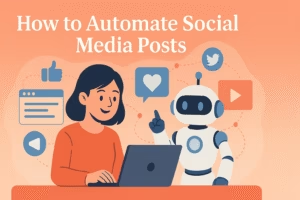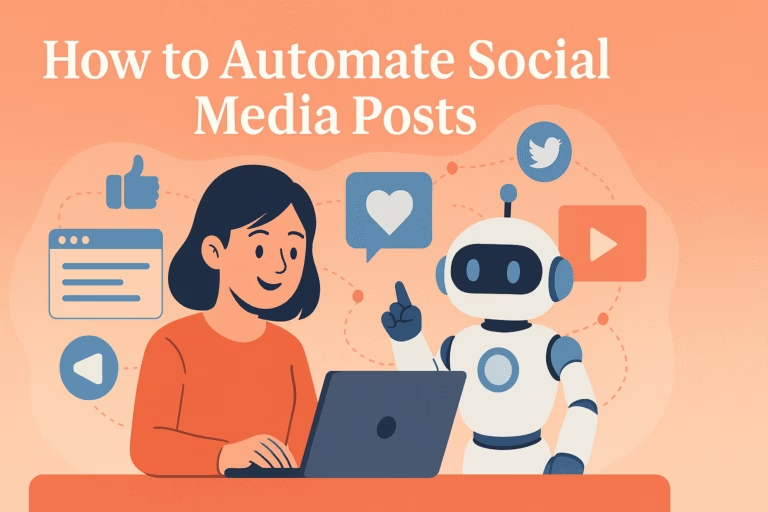Key Takeaways
- Automation should enhance creativity, not erase it. The goal is to save time while keeping your natural tone alive.
- Audiences connect more with honest, imperfect content than polished corporate language. Personality builds trust.
- Train your AI tools with real examples of your writing. The more context you give them, the more human they sound.
- Balance is key: let AI handle repetition, while you focus on storytelling, editing, and engagement.
- Agencies can scale multiple brands effectively by building and storing detailed voice maps for each client.
- Automation done right frees you from daily posting stress while keeping your message personal and consistent.
You sit staring at the blank caption box. Again.
Same brand, same tone, same hashtags you swore you’d never use again.
It used to feel creative like a conversation with your audience. Now it feels like maintenance.
Another Monday. Another post. Another reminder that social media runs on quantity, not quality.
So you automate. You schedule a week’s worth of posts. You plug in the same safe copy you’ve been recycling for months. Everything looks fine clean, consistent, professional. But when you check the analytics later, it’s flat.
Your audience can tell when you stopped talking and started broadcasting.
That’s the moment most creators start googling how to automate social media posts without losing my voice. Because you are not trying to be everywhere anymore. You are just trying to sound like yourself again.
The problem is not automation itself. It is how you automate.
Most tools optimize for output, not for authenticity.
But a few new ones, like Blaze Autopilot, are beginning to change that teaching machines to learn your tone instead of replacing it.
Before we get there, it helps to understand what traditional automation gets wrong and why it drains the life out of your content.
The Hidden Cost of Automation
Automation promised freedom, but most creators ended up feeling more mechanical than ever.
Old-school automation was built for output, not expression. It solved the scheduling problem, not the storytelling one. You got consistency, but lost connection.
Here’s how it breaks down:
The problem is that many systems never learn. They recycle phrasing, ignore tone, and push out content that sounds identical to a thousand other accounts. That sameness quietly kills engagement.
People do not unfollow immediately. They simply stop reacting.
Their attention shifts toward creators who still sound alive.
According to Buffer’s 2024 Engagement Report, posts that read as “templated” see 48 percent less interaction, even when the topic and timing are identical. Audiences reward effort, or at least the feeling of effort.
So when we talk about automating social media, the goal is not to post faster. It is to build a system that writes with memory and mood.
The next section shows why imperfection the thing most tools erase is the real secret to sounding human.

Why Humans Connect With Imperfection
Perfect content is forgettable.
What people respond to most is tone, not technique.
Human speech patterns are full of small flaws pauses, fragments, humor that slightly misses. Those irregularities build warmth. They signal that someone is real. When automation removes them, your content starts to feel clean but cold.
Psychology backs this up. Researchers at Princeton found that people trust speakers who make small verbal mistakes more than those who sound rehearsed. The same applies to writing. The best posts feel like conversation, not composition.
Think of how you react online. You scroll past posts that read like polished scripts but pause when someone writes something slightly messy yet honest. That micro-imperfection builds trust.
Here is a quick illustration:
Imperfection creates intimacy. It reminds people there is a person behind the post, not just a brand.
Modern AI systems can simulate this human rhythm if they are trained properly learning when to pause, when to use humor, and when to drop the corporate tone.
Next, we will explore exactly how to teach an AI system to sound like you instead of a template.
Section 4 – How to Teach an AI to Sound Like You
Most creators think AI ruins their voice because they never teach it what that voice actually sounds like. Any tool even a good one will sound robotic if it is fed nothing but keywords. The key is to train it like you would an intern: with examples, feedback, and guardrails.
Here is a simple five-step process that works across platforms and tools.
- Build your voice library
Collect ten posts, captions, or emails that feel the most you. The kind of writing people reply to. This becomes your voice dataset. - Label your tone
Identify what makes it unique. Are you conversational, dry, poetic, witty, or reflective? Mark these traits clearly so your AI understands them as parameters. - Feed your best examples
Paste these samples into your AI tool as context before drafting new posts. The system will learn phrasing, rhythm, and emotional cues from your writing patterns. - Edit manually twice
The first draft is where AI shows its default style. Rewrite at least two outputs to match your rhythm. Then feed those back as new examples. That fine-tunes tone precision more than any prompt tweak. - Create a review checklist
Before posting, check three things:
- Does it sound like how you speak out loud?
- Does it express emotion?
- Would you still post it if it had your name on it?
Mentioning a tool once, Blaze Autopilot can automate this process by studying your existing content library to mirror tone automatically. But even if you use another platform, the principle stays the same teach before you expect authenticity.
Next, we will look at real data showing how human-sounding automation outperforms generic scheduling by a wide margin.
The Data Layer: What Authentic Automation Looks Like
When creators talk about engagement, most focus on timing, hashtags, or algorithms. What matters more is tone. Data from multiple studies shows that audiences consistently interact more with content that sounds conversational than with polished brand copy.
Sprout Social’s 2024 report found that posts using natural language averaged 57 percent higher engagement than those written in corporate tone. Buffer’s analytics showed something similar. When a post included human expressions such as “we are excited” or “we are still learning,” the click-through rate jumped nearly 40 percent.
What this proves is simple. Authenticity scales better than automation ever could on its own. The best AI content does not sound perfect. It sounds personal.
Smart automation systems can now analyze sentence rhythm, emotional intensity, and keyword placement to simulate natural flow. Instead of posting on schedule, they post in character. The goal is not to fill slots on a calendar but to maintain emotional continuity with your audience.
This is where the next stage of automation begins. It is not about pushing more content; it is about preserving connection. A post that makes someone feel seen will always outperform one that only exists to be seen.
Next, we will build a practical workflow that keeps that human tone alive while letting automation handle the heavy lifting.
The Workflow Blueprint
Automation should make you efficient, not invisible. The key is to separate creative work from mechanical work and let each do what it does best. This workflow keeps your human touch intact while allowing your system to operate in the background.
-
Research Mondays
Spend one focused hour finding content gaps or trending topics in your niche. Use audience comments, competitor posts, and questions from forums to spark real themes. -
Creation Tuesdays
Feed those topics into your AI assistant to draft ideas and post variations. Choose three to five that sound most natural. Edit only for clarity, not perfection. Readers connect with honesty, not polish. -
Edit Wednesdays
Read each post aloud. If it sounds like something you would actually say, keep it. If not, trim formal words and add small quirks or phrasing you naturally use. Authenticity often hides in imperfection. -
Schedule Thursdays
Load your approved posts into your automation tool. If you use Blaze Autopilot, this is where it handles timing, platform targeting, and optimization automatically. Set it, check the preview, and step away. -
Engage Fridays
No matter how automated your system becomes, direct engagement cannot be outsourced. Reply to comments, share user posts, and add quick thank-you notes. The smallest human gesture keeps your audience loyal.
This rhythm works because it respects balance. Humans handle creativity and connection. Machines handle repetition and delivery. The two together form a sustainable cycle that builds presence without pressure.
Next, we will look at how agencies can apply the same structure across multiple clients without losing each brand’s individuality.
For Agencies: Scaling Without Losing Humanity
Agencies face a different problem from solo creators. It is not about one voice, but many. Managing ten or more brands at once means juggling tones, styles, and client expectations that change weekly. This is where structured automation becomes survival, not luxury.
The challenge is that traditional automation systems flatten every account into the same neutral voice. You save time, but every post sounds like it came from the same ghostwriter. The fix is simple in theory but rare in practice. You need a documented voice map for every client.
A voice map is a small internal file with three short sections.
-
Tone description: friendly, corporate, playful, expert.
-
Vocabulary field: words they use and words they avoid.
-
Emotional cues: how the brand handles praise, criticism, or humor.
Once that is created, it can be fed into your automation tool before generating drafts. Some systems can even store multiple profiles and automatically switch voices depending on which brand you are working on.
This method allows agencies to scale creative work while keeping individuality intact. Each post still sounds personal because the machine is not writing from scratch; it is writing from a library of defined identities.
That is how the best agencies now manage dozens of clients with small teams. They stop trying to write faster and instead build systems that think in voices.
Next comes the final reflection. It brings together everything we have covered and explains why the future of automation will belong to those who sound most human.
Final Reflection
Automation is not the enemy of creativity. The enemy is forgetting why you started creating in the first place.
Most people use AI to post more. The smarter ones use it to post better. The goal is not to remove yourself from your content but to remove the friction that keeps you from showing up. When you automate with intention, your system works while your voice still leads.
What audiences crave online is not perfect grammar or endless posts. They crave tone, honesty, a glimpse of personality behind the pixels. If you train your tools to reflect that, automation stops feeling like compromise and starts feeling like clarity.
Machines can handle the noise, but meaning is still your job. Every authentic line you write becomes training data for the voice you want to scale. That is how you build trust, even at algorithmic speed.
So automate boldly. Just never automate yourself out of your own story.




Pingback: I Tested AI Business Automation for 60 Days — Now My Business Runs Itself - AI TIPSTERS